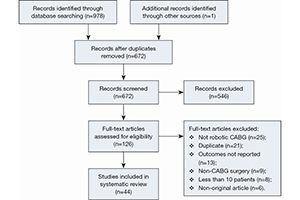A systematic review on robotic coronary artery bypass graft surgery
Abstract
Background: Robotic-assisted coronary artery bypass graft surgery (CABG) has been performed over the past decade. Despite encouraging results from selected centres, there is a paucity of robust clinical data to establish its clinical safety and efficacy. The present systematic review aimed to identify all relevant clinical data on robotic CABG. The primary endpoint was perioperative mortality, and secondary endpoints included perioperative morbidities, anastomotic complications, and long-term survival.
Methods: Electronic searches were performed using three online databases from their dates of inception to 2016. Relevant studies fulfilling the predefined search criteria were categorized according to surgical techniques as (I) totally endoscopic coronary artery bypass without cardiopulmonary bypass (TECAB off-pump); (II) TECAB on-pump; and robotic-assisted mammary artery harvesting followed by minimally invasive direct coronary artery bypass (robotic MIDCAB).
Results: The present systematic review identified 44 studies that fulfilled the study selection criteria, including nine studies in the TECAB off-pump group and 16 studies in the robotic MIDCAB group. Statistical analysis reported a pooled mortality of 1.7% for the TECAB off-pump group and 1.0% for the robotic MIDCAB group. Intraoperative details such as the number and location of grafts performed, operative times and conversion rates, as well as postoperative secondary endpoints such as morbidities, anastomotic complications and long-term outcomes were also summarized for both techniques.
Conclusions: A number of technical, logistic and cost-related issues continue to hinder the popularization of the robotic CABG procedure. Current clinical evidence is limited by a lack of randomized controlled trials, heterogeneous definition of techniques and complications, as well as a lack of robust clinical follow-up with routine angiography. Nonetheless, the present systematic review reported acceptable perioperative mortality rates for selected patients at specialized centres. These results should be considered as a useful benchmark for future studies, until further data is reported in the form of randomized trials.
Cover






